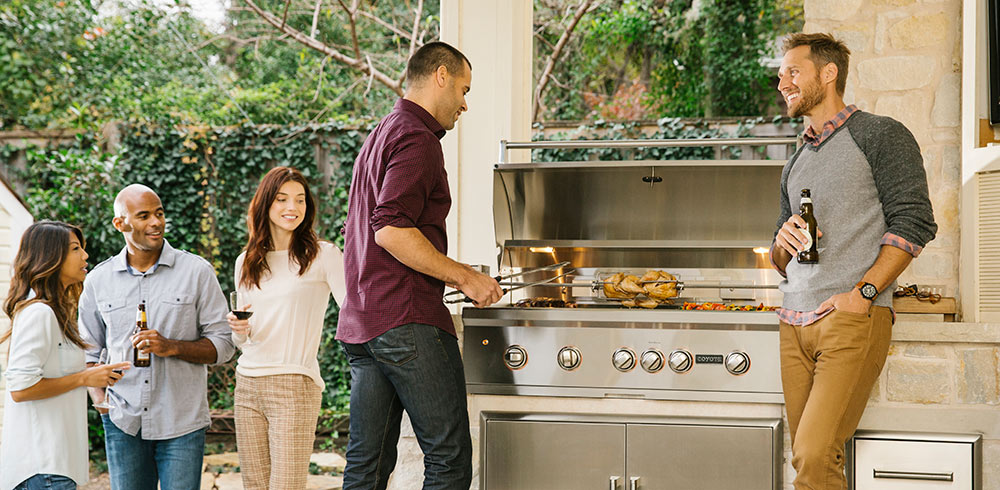
How to Build an Outdoor Kitchen
Adding an outdoor kitchen to your backyard is a surefire way to create the ultimate backyard barbecue experience. Whether youâre renovating an existing area or building from scratch to your exact specifications, thereâs a lot youâll need to consider when planning your space. This guide has been designed with help from our outdoor kitchen and grill experts and will give you a great place to start your planning process.
When planning for an outdoor kitchen, you should consider these two things:
- What grill(s) & component(s) to include in your outdoor kitchen
- How to design and build your outdoor kitchen
What to Include in Your Outdoor Kitchen

The best products for your outdoor kitchen will be determined by your space requirements, budgetary restrictions, and cooking style. This means thereâs not really a âone size fits allâ solution for building your outdoor kitchen. While some pre-configured designs exist, weâre going to assume youâre looking to design a completely custom outdoor kitchen, so the general recommendations below are widely applicable regardless of your individual situation.
Below is a list of the main outdoor kitchen components to consider - while there are others, the below list covers the most common items necessary to create the ultimate backyard BBQ oasis.
- Grills & Appliances
- Outdoor Kitchen Components
Grills & Other Appliances to Put in Your Outdoor Kitchen
Above all else, your grill will be the most important part of your outdoor kitchen. Selecting the wrong built-in grill for your situation can leave you feeling unsatisfied with your space no matter how perfectly you select the rest of your components. Here are some general guidelines to follow.
Choosing the Grill for Your Outdoor Kitchen

Charcoal or gas? Propane or natural gas? What features will you need? Below we'll cover some high-level considerations when it comes to the grill for your outdoor kitchen, but be sure to check out both our gas grill buying guide and charcoal grill buying guide for more depth & detail about the ins and outs of premium grills.
Grill Sizing and Installation when Building an Outdoor Kitchen

If youâll be cooking for family get-togethers or parties, youâll obviously want a larger grill. On the other hand, buying a grill thatâs too large can result in less room in your budget for other parts of your build. How can you tell how much space you really need, though? As a general rule, youâll want 100 square inches of cooking space for each person youâll be cooking for on a regular basis.
Alternative Cooking Appliances for Your Outdoor Kitchen
Side Burners

In addition to your main grill head, you may want to consider adding a side burner or range to your grill island. Single side burners exist, but most people choose to install either a double side burner or a power burner for more efficient wok cooking, water boiling or side dish preparation. These useful components can expedite your cooking process and in some cases, can save you from needing to use your indoor kitchen while grilling.
Keep in mind some grill heads may also include integrated secondary cooking areas, so whether or not youâll need additional burners will depend on your cooking style.
Gas Griddles & Flat-Tops

Traditional grills don't have to be the only star in your outdoor kitchen - griddles & flat-tops offer additional versatility & cooking options. Whether diner-style smash-burgers, an All-American breakfast, or an Asian-inspired hibachi, cooking on a flat-top offers plenty of delicious options, and you shouldn't sleep on adding a griddle to your outdoor kitchen.
Grill Island Essentials
After youâve selected the grill and side burner configuration youâll be buying, itâs time to start thinking about the additional grill island components youâll need for your space. These pieces are where youâll really need to think about how youâll be using your outdoor kitchen. Youâll also want to review the âHow to Set Up Your Outdoor Kitchenâ section below to make sure all of your pieces integrate well into your intended design.
Outdoor Kitchen Doors, Drawers, & Storage

Storage doors and drawers can be as numerous or as minimal as you need them to be. While many people like to keep all of their grill tools and accessories right at the grill, others may choose to store these items in their homes, which reduces some of the need for extensive storage within the grill island.
Most buyers select doors and drawers designed to match the brand of BBQ grill theyâre buying. Manufacturers take care in creating a uniform design across their entire product line to create an impressive appearance when all pieces are paired together. That said, this is not a requirement. In fact, customers will sometimes choose more economical storage options such as those from Blaze Grills. These components feature no branding and a neutral appearance but retain high quality. The result is cost savings that can be spent elsewhere in the kitchen design.
Outdoor Kitchen Refrigeration

If you want to keep drinks, food prep ingredients and other cold items close by, youâll want to include a refrigerator in your outdoor kitchen space. Be sure to keep in mind the difference between outdoor-rated and unrated refrigerators. Outdoor-rated appliances feature front vents, better warranties and are designed to be left outside. Alternatively, unrated refrigerators are a more economical option, but are not designed for direct exposure to the elements.
Outdoor Kitchen Sinks

An outdoor sink is by no means a requirement for an outdoor kitchen. However, the added convenience is often worth the money for most buyers. An outdoor sink is a great way to reduce traffic (and messes) in your house when grilling.
There are several factors to consider when choosing a sink. Do you want a gravity drain or not? Are faucets included or do they need to be purchased separately? What components are required for plumbing? These details will vary across models, so be sure to consult the ownerâs manual.
Secondary Considerations
The following products are more often considered ânice to haveâ rather than ânecessary.â If youâre looking to create a dream kitchen, though, be sure to consider each, as some may be more relevant to your situation than others.
Outdoor Beverage Centers

Want to make drinks after dinner? A cocktail station or outdoor bar caddy can keep the party going long into the night. With one of these, youâll be able to separate dinner fixings from the cocktail garnishes to keep your space neat and organized.
Drop-In Ice Cooler

If a refrigerator is too big an expense or wonât work with your space, consider a drop-in ice cooler as a substitute. While youâll lose some of the convenience of a standalone refrigeration unit, youâll instead have lower energy bills and less chance of untimely breakdowns.
Outdoor Kitchen Warming Drawers

Need to keep your food from getting cold as quickly? Consider adding a warming drawer to your setup. These units are a great way to keep food warm while the rest of the meal finishes cooking or keeping food appetizing when you or your guests go back for seconds.
How to Design Your Outdoor Kitchen
Once youâve selected the parts youâd like to include in your outdoor kitchen, youâll need to go about installing them. This will require a proper layout, quality construction, and essential fuel and electricity connections. Thereâs a lot to consider, so weâve broken down these details into several categories to make the process easier for you.
Design Considerations for Outdoor Kitchens:
- Grouping Outdoor Kitchen Components
- Grill Island Construction
Component Groupings
Outdoor kitchens should be laid out to facilitate ease of use. While these rules arenât necessarily requirements, consider them strong suggestions to help you create a much more enjoyable outdoor grilling experience.
Hot/Cold Zone Groupings

When designing your kitchen layout, try to group similar items together. In other words, youâll want to have hot zones for your grill head, burners, and other cooking components and cold zones for refrigeration. Additionally, youâll want dry zones for food preparation and storage and wet zones for components like sinks.
Countertop Considerations
Item groupings shouldnât be your only zone considerations, however. Youâll also want to leave plenty of open countertop space for prep zones, serving & drinks, as well as clearances for your grill & the heat it will produce. Here are some general guidelines:
- ~36 Inches adjacent to the grill / cooking appliance
- This may sound like a lot, but think about how big cutting boards, sheet trays full of meat, or large serving platters can be. You'll thank yourself for all of the added space.
-
~18 Inches on both sides of the sink.
- Space for clean or dirty dishes alike is always helpful.
-
~15 Inches of counter space above or near a refrigerator.
- Accommodating room for beverages, crucial to a great outdoor kitchen.
Building Your Grill Island
The grill island is the skeleton that holds all of your outdoor kitchen equipment. Designs can be utilitarian, ornate, or anything in between. No matter what your grill island ultimately looks like when finished, hereâs what you should know during the building process.
Grill Island Shape
The shape of the outdoor kitchen can take any form to fit your space. Most commonly, a linear or L-shape are used to provide the most usable space for your patio, but design the shape of the grill island with your own space in mind. Also, keep in mind how you'll use it & entertain with it, do you need to accommodate seating? bar height stools? These are just a couple of the things to consider when designing the shape of the grill island.

Grill Island Materials

Grill islands are typically made from pressure-treated wood with a brick facade, full masonry or steel studded with concrete backer board. In addition, treated wood and steel structures typically have additional stonework or stucco to finish the design. If youâre installing into a combustible structure, you will also need an insulating jacket to ensure a safe installation.
For the countertop, most buyers will use poured concrete or granite, but other options are also available.
Grill Island Dimensions

Grill islands come in all shapes and sizes, but there are several standards youâll want to keep in mind with your design. First and foremost, be sure to review the manufacturer manuals for your grill and components. These will include cut sheets and clearance requirements youâll need to accommodate for proper installation.
Other dimensions you may want to keep in mind are counter height (36 inches is standard), depth ranges (typically between 25 and 30 inches) and bar height (usually 42 inches with 24 to 30 inches per person for seating).
Locating Your Grill Island

Your grill will likely be located in one of two locations: either near the house or under a special structure. If installing your grill near the house, take extra care to ensure proper installation. All grills will always have clearance requirements for houses. Failure to follow these instructions can result in your dream kitchen becoming a nightmare.
If youâre installing your grill under an overhead structure like a lanai or pergola, youâll have additional precautions youâll need to follow. These structures will often have issues with grease or dirt buildup, which can present a fire hazard if not regularly addressed. Many of these problems can also be mitigated with proper ventilation. Again, be sure to follow all manufacturer specifications.
Grill Island Connections
Most grill islands will not be completely independent units. Youâll need to make additional connections to ensure everything is operating properly. Here are some examples of what youâll need to consider.
Electricity

Does your grill have an electronic ignition? An electric rotisserie kit? Integrated lighting? Chances are, youâre going to need an external power source. When designing your grill island, be sure all proper electrical connections are available and have been installed by a licensed electrician.
Gas Lines

Unless youâll be purchasing a charcoal grill or using a portable propane tank, youâll need to run gas lines to your grill island to fuel your new appliances. Before buying, make sure youâve considered whether youâll need propane or natural gas. While it may seem obvious, weâve seen instances of customers buying the wrong grill type for their home. Donât be that person.
Always work with an NFI-certified gas plumber when working with gas lines. Gas can be tricky to work with, so youâll want an expert involved to ensure your setup is safe and operating properly.
Water Line

If you plan on installing an outdoor sink, ice maker, beverage center, or any other appliance that will need a hookup to a water line, be sure to account for it.
Venting

Be sure your grill island is properly vented to ensure safety. Venting is required and is typically placed on either end of the island. For more information, be sure to check your ownerâs manual.
Drainage is another important factor to consider when building your grill island. Often, a drain is placed in the island to evacuate water after rain. Additionally, the drain can be used for any sinks or refrigerators in the outdoor kitchen setup.
Get More Assistance from Our Experts
We hope youâve found this guide helpful. However, we completely understand if youâre currently suffering from information overloadâthereâs a lot to take in here. Fortunately, our product specialists are available to assist you further.
If you have any questions about anything youâve read here or youâd just like to have an expert in your corner, our team can guide you through the entire process from initial design to making your purchase to troubleshooting your installation. You can contact us by phone Monday through Friday from 8 a.m. to 5 p.m. Central Time or anytime via email.
Weâre looking forward to working with you!
Looking for the perfect components for your outdoor kitchen?



